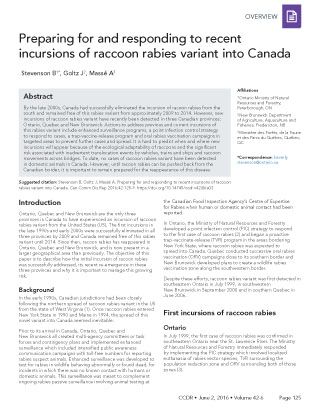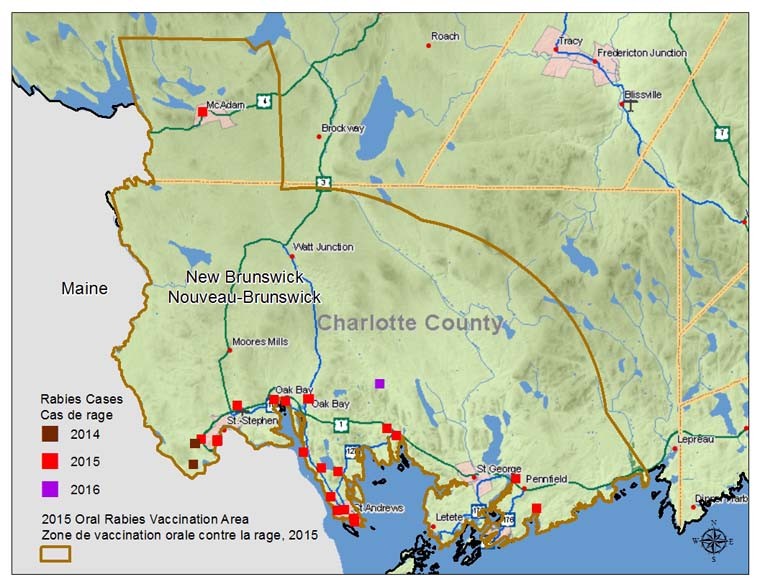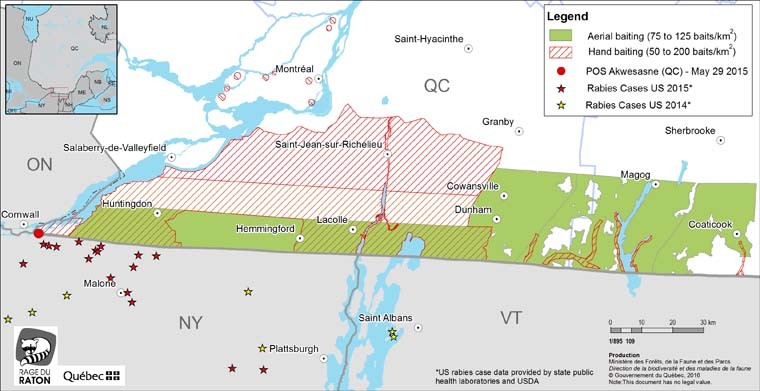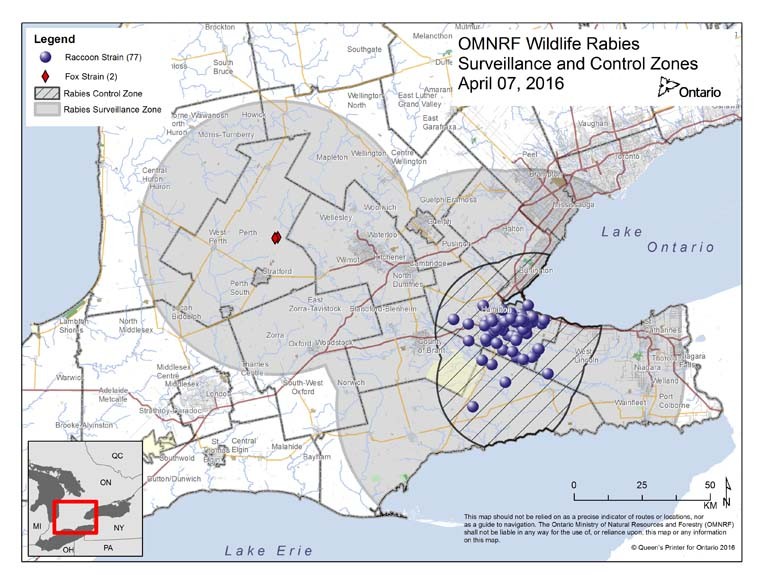Incursions of racoon rabies variant into Canada

 Download this article as a PDF (1.5 MB - 5 pages)
Download this article as a PDF (1.5 MB - 5 pages) Published by: The Public Health Agency of Canada
Issue: Volume 42-6: Rabies
Date published: June 2, 2016
ISSN: 1481-8531
Submit a manuscript
About CCDR
Browse
Volume 42-6, June 2, 2016: Rabies
Overview
Preparing for and responding to recent incursions of racoon rabies variant into Canada
Stevenson B1*, Goltz J2, Massé A3
Affiliations
1 Ontario Ministry of Natural Resources and Forestry, Peterborough, ON
2 New Brunswick Department of Agriculture, Aquaculture and Fisheries, Fredericton, NB
3 Ministère des Forêts, de la Faune et des Parcs du Québec, Québec, QC
Correspondence
Suggested citation
Stevenson B, Goltz J, Massé A. Preparing for and responding to recent incursions of raccoon rabies variant into Canada. Can Comm Dis Rep 2016;42:125-9. https://doi.org/10.14745/ccdr.v42i06a03
Abstract
By the late 2000s, Canada had successfully eliminated the incursion of racoon rabies from the south and remained free of this rabies variant from approximately 2009 to 2014. However, new incursions of raccoon rabies variant have recently been detected in three Canadian provinces: Ontario, Quebec and New Brunswick. Actions to address previous and current incursions of this rabies variant include enhanced surveillance programs, a point infection control strategy to respond to cases, a trap-vaccine-release program and oral rabies vaccination campaigns in targeted areas to prevent further cases and spread. It is hard to predict when and where new incursions will appear because of the ecological adaptability of raccoons and the significant risk associated with inadvertent translocation events by vehicles, trains and ships and raccoon movements across bridges. To date, no cases of raccoon rabies variant have been detected in domestic animals in Canada. However, until racoon rabies can be pushed back from the Canadian border, it is important to remain prepared for the reappearance of this disease.
Introduction
Ontario, Quebec and New Brunswick are the only three provinces in Canada to have experienced an incursion of raccoon rabies variant from the United States (US). The first incursions in the late 1990s and early 2000s were successfully eliminated in all three provinces by 2009 and Canada remained free of this rabies variant until 2014. Since then, racoon rabies has reappeared in Ontario, Quebec and New Brunswick, and is now present in a larger geographical area than previously. The objective of this paper is to describe how the initial incursion of racoon rabies was successfully addressed, its recent re-emergence in these three provinces and why it is important to manage this growing risk.
Background
In the early 1990s, Canadian jurisdictions had been closely following the northern spread of raccoon rabies variant in the US from the state of West Virginia Footnote 1. Once raccoon rabies entered New York State in 1990 and Maine in 1994, the spread of this novel variant into Canada seemed inevitable.
Prior to its arrival in Canada, Ontario, Quebec and New Brunswick all created multi-agency committees or task forces and contingency plans and implemented enhanced surveillance which included intensified public awareness communication campaigns with toll-free numbers for reporting rabies suspect animals. Enhanced surveillance was developed to test for rabies in wildlife behaving abnormally or found dead, for incidents in which there was no known contact with humans or domestic animals. This surveillance was meant to complement ongoing rabies passive surveillance involving animal testing at the Canadian Food Inspection Agency’s Centre of Expertise for Rabies when human or domestic animal contact had been reported.
In Ontario, the Ministry of Natural Resources and Forestry developed a point infection control (PIC) strategy to respond to the first case of raccoon rabies Footnote 2 and began a proactive trap-vaccinate-release (TVR) program in the areas bordering New York State, where raccoon rabies was expected to spread into Canada. Quebec conducted successive oral rabies vaccination (ORV) campaigns close to its southern border and New Brunswick developed plans to create a wildlife rabies vaccination zone along the southwestern border.
Despite these efforts, raccoon rabies variant was first detected in southeastern Ontario in July 1999, in southwestern New Brunswick in September 2000 and in southern Quebec in June 2006.
First incursions of raccoon rabies
Ontario
In July 1999, the first case of raccoon rabies was confirmed in southeastern Ontario near the St. Lawrence River. The Ministry of Natural Resources and Forestry immediately responded by implementing the PIC strategy which involved localized euthanasia of rabies vector species, TVR surrounding the population reduction zone and ORV surrounding both of those zones Footnote 3.
From 1999 to 2005, Ontario had 132 confirmed cases of raccoon variant rabies (130 raccoons and two striped skunks) before it was successfully eliminated from the province Footnote 4. The outbreak was contained to two localized areas and spread approximately 2,000 km2 from 1999 to 2005. The second incursion occurred on Wolfe Island in the St. Lawrence River in the winter of 1999-2000 Footnote 5. That outbreak was quickly thwarted through enhanced rabies surveillance, TVR and aerial baiting with RABORAL V-RG®.
After elimination, the Ministry of Natural Resources and Forestry continued enhanced surveillance in the areas bordering New York State since rabies cases were still occurring throughout New York State and the eastern US. The Ministry continued TVR in the St. Lawrence and Niagara areas of Ontario to create a buffer of vaccinated raccoons until 2007 and 2008 respectively Footnote 4 when TVR was replaced with aerial baiting using a new vaccine (ONRAB®) which was effective at immunizing raccoons, skunks and foxes. Since that time, ORV has been conducted in the Niagara Peninsula between the Welland Canal and the Niagara River and in a selected area along the St. Lawrence River in eastern Ontario adjacent to locations where rabies is occurring in New York State, especially near bridgeheads where it is easier for raccoons to cross the St. Lawrence River.
New Brunswick
In September 2000, the first case of raccoon rabies was confirmed in southwestern New Brunswick in a road-killed striped skunk, causing speculation that rabies may have been present for some time. From September 2000 to May 2002, a total of 64 rabid wild animals (55 raccoons and nine striped skunks) were confirmed in the same general geographic area.
Measures to control the spread of rabies in the key wildlife rabies vector species (raccoons, striped skunks and red foxes) were employed, including population reduction and TVR (using IMRAB®3 vaccine), in late September of 2001 using a cadre of local trappers under the direction and leadership from the Department of Health. Feral cats (defined as cats with no identification or collars) were also vaccinated when captured in live traps. Only three rabid animals were detected in 2002 and the last one was confirmed in May of that year.
Additional components of New Brunswick’s response included enhanced rabies surveillance, targeted awareness campaigns for health care and veterinary health care professionals, and a public awareness campaign that promoted safe enjoyment of wildlife from a healthy distance, encouraged the public to report animals exhibiting strange behaviours, and promoted pet vaccination.
New Brunswick continued its TVR activities through the fall of 2007, then did one year of ORV using ONRAB® in 2008. Maine and New Brunswick collaborated on control activities for several years toward the end of this time period, with complementary activities on both sides of the border in the geographic areas of highest risk. During this time, Maine conducted an ORV program with RABORAL V-RG®. After 2008, New Brunswick discontinued its wildlife rabies prevention and control measures and reduced surveillance activities, since the raccoon rabies variant had been successfully eliminated from the province but also as a result of changing mandates.
Quebec
The first case of raccoon rabies in Quebec was confirmed in June 2006 in a road-killed raccoon located in Dunham (Montérégie region) about 10 km north of the Quebec-Vermont border. Following that discovery, emergency actions were put into place and a PIC strategy was implemented. Aerial vaccination using RABORAL V-RG® around the PIC zones was also conducted.
From 2006 to 2009, a total of 104 raccoon rabies cases (89 raccoons, 14 striped skunks and one red fox) were confirmed in southern Quebec, in the Montérégie region. During the first two years of the outbreak, control measures focused primarily on the PIC strategy (population reduction, TVR and ORV). However, since the infected zone covered more than 1,500 km2 by 2007, it became unrealistic to continue PIC operations so subsequent operational strategies focused mainly on ORV.
Raccoon rabies elimination was accomplished in a relatively short period (four years) as a result of consistent teamwork and research collaboration. This success was likely due to a management program that included these key measures:
1) enhanced rabies surveillance that involved technicians patrolling roads along the QC-US border and responding to reports by citizens of dead or strange acting animals Footnote 6; 2) the use of ONRAB® vaccine baits for ORV operations Footnote 7,Footnote 8; 3) combined aerial and hand baiting depending on the landscape and habitat composition; and 4) adapting bait distribution and densities to focus on raccoon and skunk habitat.
Since 2010, even though Quebec was considered raccoon rabies free, the threat of a new introduction from the US was still real and of management concern due to the absence of natural barriers and the occurrence of several raccoon rabies cases in states close to the Quebec border. Consequently, the province has continued its raccoon rabies management program for ten consecutive years, including spring and late summer ORV along the QC-US border (about 700,000 ONRAB® baits distributed annually over 6,900 km2), enhanced surveillance (between 800 and 1,000 animals tested for rabies per year over an area of 11,300 km2) and communications encouraging public awareness.
Recurrence of raccoon rabies
New Brunswick
No cases of raccoon rabies variant were detected in New Brunswick from May 2002 until late May 2014, when a family in St. Stephen, in southwestern New Brunswick, arrived home to see their two dogs circling a raccoon in its back yard. The raccoon was killed and buried. Because of the abnormal behaviour of the racoon, its body was later exhumed and tested positive for rabies. A rabid striped skunk was detected in the same general area in October 2014 and 25 additional rabid animals (24 raccoons and one striped skunk) were subsequently detected in southwestern New Brunswick between mid-January 2015 and mid-March 2016 (Figure 1).
In August 2015, New Brunswick hired a provincial rabies coordinator. Later that month, the province implemented an ORV program, under the leadership of the Department of Agriculture, Aquaculture and Fisheries, in an area of about 3,000 km2 in the southwestern part of the province (Figure 1) using ONRAB® rabies vaccine baits. A total of 206,000 vaccine baits were distributed: 153,000 by plane (thanks to assistance from the Ontario Ministry of Natural Resources and Forestry air crew), 36,000 by helicopter and 17,000 by hand.
Since the winter and spring of 2015, New Brunswick has conducted enhanced surveillance for rabies in the southwestern portions of the province. Most specimens are also checked for other diseases such as canine distemper.
Figure 1: Raccoon rabies variant cases in New Brunswick in 2014 and 2015, and oral rabies vaccination (ORV) zone of response in 2015

Text description: Figure 1
Figure 1: Raccoon rabies variant cases in New Brunswick in 2014 and 2015, and oral rabies vaccination (ORV) zone of response in 2015
This is a map of the southwestern part of New Brunswick. It shows the area of oral rabies vaccination; this covers a good section of this part of the province, extending to its border with the state of Maine and the coast line along the Bay of Fundy and then well into the central part of the province. With the use of colored boxes, it shows the number of cases of rabies found from 2014 to2016. In 2014, there were two cases of rabies right near the border with the state of Maine. In 2015, there were 17 cases of rabies, mostly along the coast and bordering with the state of Maine, but with one case quite far from the coast near McAdam. To date in 2016, one case of rabies has been identified that was significantly inland, north of St. Andrews.
In 2016, New Brunswick plans to expand its ORV zone and area of enhanced surveillance, to conduct wildlife rabies vector population density research and to secure funding for PIC responses to address any rabies cases that are detected beyond the current control area.
Quebec
Since the spring of 2015, the Quebec government has enhanced its surveillance and control activities following the discovery of rabid raccoons in Franklin County, New York State, a few kilometers south of the Quebec border. On May 29, 2015, a case of raccoon rabies was confirmed in the Quebec portion of the Akwesasne First Nations reserve, where no vaccination campaign to immunize wild animals against rabies had ever been conducted previously (Figure 2).
Figure 2: Oral rabies vaccination (ORV) operations and positive raccoon rabies case in Quebec in 2015

Text description: Figure 2
Figure 2: Oral rabies vaccination (ORV) operations and positive raccoon rabies case in Quebec in 2015
This is a map of Southern Quebec that shows the extent and type oral rabies vaccination operations and where racoon rabies has been found in Quebec and bordering states. In 2014, there were seven rabies cases identified in upper New York State and northern Vermont. In 2015, there were 17 cases of rabies identified in upper New York State, this time closer to the border with Quebec than in 2014. The one positive case in Quebec was identified at the southwestern tip of the province at the Akwasasne reserve in May 2015. Through contrasting colors it shows the rabies vaccine operations. There has been aerial baiting along the southern border of Quebec extending almost from the border with Ontario to slightly past Coaticook in the mid-part of the province and as far north as Magog. Hand baiting has been done in the southwestern tip of the province and just above the strip of aerial bating, along the St. Lawrence River and almost as far north as Granby as well as in nine areas on the Island of Montreal. Hand baiting also overlapped with some of the areas of aerial baiting in the southwestern part of the province, east of Hemmingford to past Lake Champlain, and along specific routes from the US border between Dunham and Coaticook.
Following the discovery of this case, 2,100 ONRAB® vaccine baits were distributed by hand in mid-June and late August in collaboration with the Akwesasne and Ontario authorities. Although this was the first raccoon rabies case in Quebec since 2009, it did not pose a more important threat to the rest of Quebec than the current Franklin County, New York outbreak (15 cases within 15 km of Quebec), since the habitat between Akwesasne and the Montérégie region is not suitable for raccoon and skunk movements. Nevertheless, there is now a real risk of raccoon rabies spreading into Quebec, so in 2015, surveillance was intensified in areas located near Franklin County to rapidly detect any new cases and react promptly. Vaccination operations were also adjusted in these areas, through increased baiting density and an expanded baiting zone, to reinforce immunity of raccoons along the border and to help make sure raccoon rabies does not spread into Quebec again. About 690,000 ONRAB® baits were distributed in 2015, 330,000 by hand over 3,900 km2 and 360,000 by plane over 4,000 km2 (Figure 2). Enhanced surveillance and control operations will be conducted in 2016 and will be adapted to the current epidemiological situation in Quebec and neighbouring US states.
Ontario
On December 4, 2015, Hamilton Animal Control picked up a sick raccoon and two dogs. Although initially confined to individual holding cages, one dog and the raccoon managed to escape their cages and get into a fight. The raccoon was submitted for rabies testing and raccoon rabies variant was once again confirmed in Ontario. This time it was in the “Golden Horseshoe”, a highly populated area inhabited by over 8 million people at the western end of Lake Ontario, posing a greater human risk than in the more rural area where the 1999 outbreak occurred.
Despite the time of year, the mild temperatures associated with El Niño made it prudent for rabies control measures to be implemented immediately as raccoons had not entered their typical winter denning and periods of inactivity which would normally help slow the spread of rabies.
Within days of receiving confirmation of the variant type, the local health unit issued a news release about the case discovery and planned baiting operations and the Ministry of Natural Resources and Forestry staff began distributing baits throughout the urban areas by hand and helicopter. As additional cases were confirmed, baits were distributed in a 25 km radius around all of the existing confirmed cases in hopes that this vaccination zone would cover the extent of the disease. Approximately 220,000 ONRAB® baits were distributed in urban, suburban and rural areas surrounding the cases within three weeks.
As of April 7, 2016, 77 cases (53 raccoons and 24 stripped skunks) have been confirmed over approximately 600 km2 (Figure 3), suggesting that the disease had been established in the area for some time. A surveillance zone was established within a 50 km radius of all confirmed cases to determine the extent of the spread and what resources would be required to contain it. Almost 2,000 raccoons and skunks have been tested through enhanced surveillance since December 2015 using direct Rapid Immunohistochemical Test for Rabies (dRIT) Footnote 9. ORV will be conducted in summer 2016 in a 50 km radius around all confirmed cases (Figure 3).
Figure 3: Rabies cases and surveillance and control zones in Hamilton area, Ontario as of April 2016

Text description: Figure 3
Figure 3: Rabies cases and surveillance and control zones in Hamilton area, Ontario as of April 2016
This is a map showing the area around the area of Hamilton Ontario. It shows that there have been 77 cases of rabies strain identified in the Hamilton area, and two cases of fox strain rabies identified north of Stratford Ontario as of April 7, 2016. It shows a broad surveillance zone for rabies in a 50-km radius around the fox rabies cases and in an approximately 75 km radius around Hamilton, Ontario, along Lake Ontario extending into Missasauga on the North and Niagara and along Lake Erie in the South. There is an additional Rabies control zone of approximately a 30 km radius around Hamilton, Ontario.
Discussion
Previous incursions of raccoon rabies variant in Canada have been successfully eliminated, but all three provinces where it has previously occurred are now dealing with new incursions.
It is challenging to predict when or where new incursions of racoon rabies will appear. This is due in part to surveillance gaps, but also because of the ecological adaptability of raccoons and significant risk associated with their translocation by vehicles, trains and ships, as well as movement across bridges. Ontario’s recent epizootic in the Hamilton area was initially obscured by an outbreak of canine distemper occurring in the same geographic area and causing similar clinical signs among raccoons and other susceptible species. New Brunswick’s current epizootic covers a much broader geographic area than the previous outbreak, likely reflecting gaps in surveillance and delays in response. Unlike the US, no cases of raccoon rabies variant have yet been detected in domestic animals in Canada.
Until raccoon rabies can be pushed back from the Canadian border, it will be important to prepare for the reappearance of the disease and to ensure that resources and knowledge are available to respond to the threat. Without control measures or natural geographic barriers, raccoon rabies advances approximately 40 km per year Footnote 1. In order to protect against the threat of re-incursion, raccoon rabies must be pushed back at least 40 km from the border, although there is still the need to be alert for “hitchhiking raccoons” (i.e. raccoon getting on boats or vehicles).
The North American Rabies Management Plan Footnote 10, signed in 2008 by Canada, the US, Mexico and the Navajo Nation, outlines strategies for collaboration and coordination of control measures to stop the northward and westward spread and eventual elimination of raccoon rabies. Although some headway has been made, real long-term progress toward raccoon rabies elimination has been limited and continues to prove challenging.
Despite having the knowledge and tools available to successfully contain, control and eliminate rabies from each of the individual provinces, there is a need to maintain and advance our capacity to promptly detect the re-emergence of rabies and to respond quickly when it occurs. It is important to maintain surveillance efforts and not lapse into a false sense of security simply because rabies was successfully eliminated in the past. If left unchecked, there is a risk that the re-emergence of racoon rabies could have a significant economic impact due to increased costs associated with the need for additional post-exposure prophylaxis. It could also have a negative effect on local wildlife populations and increase public anxiety about the possibility of people and pets contracting this fatal disease Footnote 11. Agencies must also continue to collaborate at the municipal, provincial, national, and international level in order to stay abreast of current research and the current status of rabies in neighbouring areas. Excellent communications and networking among governments, fur harvesters, animal control, wildlife rehabilitators, First Nations and other non-governmental agencies will advance our capacity to respond to future rabies incidents.
Acknowledgements
The authors thank all those who have worked diligently to prevent, detect and respond to rabies in Canada for their hard work and willingness to share expertise and provide advice.
Conflict of interest
None.